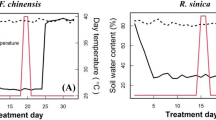Abstract
Internal pressurization and convective gas flow in emergent wetland plants is a function of the water vapour pressure deficit (WPD) and stomatal conductance (G s) separating the external atmosphere from the internal aerenchyma. We have compared the effects of WPD and G s under a range of light intensities on static pressures and convective flows in Phragmites australis, Typha orientalis and Baumea articulata. The capacity of the three species to generate flows per unit leaf area differed, being greatest in P. australisand lowest in B. articulata. In all three species, decreasing light intensity from full sunlight (2200 μmol m−2 s−1 photosynthetically active photon flux density (PPFD)) to < 200 and < 10 μmol m−2 s−1PPFD caused immediate decreases in photosynthetic assimilation, followed by more gradual decreases in transpiration and G s. However, internal pressures and flows in the two low light intensities remained similar to values recorded in full sunlight. WPD was more significantly related to pressures and flows in P. australis and T. orientalis than G s. In B. articulata, pressures increased at low G s values but flow rates were unaffected, as predicted by earlier models describing pore size effects on pressures and flows. The data suggest that emergent macrophytes can maintain significant internal convection even at low light intensities, and this may be beneficial for nocturnal aeration, particularly in arid climates where the atmospheric humidity at night is low.
Similar content being viewed by others
References
Aldridge K 2001 Modification of sediment redox potential by Typha domingensis: implications for phosphorus adsorption/desorption. Abstract, Australian Society of Limnology 40th Congress 21. Moama, NSW, Australia 28–30 September 2001.
Arkebauer T J, Chanton J P, Verma S B and Kim J 2001 Field measurements of internal pressurization in Phragmites australis (Poaceae) and implications for regulation of methane emissions in a midlatitude prairie wetland. Am. J. Bot. 88, 653–658.
Armstrong J and Armstrong W 1990 Light-enhanced convective throughflow increases oxygenation in rhizomes and rhizosphere of Phragmites australis (Cav.) Trin. ex Steud. New Phytol. 114, 121–128.
Armstrong J, Armstrong W, Beckett P M, Halder J E, Lythe S, Holt R and Sinclair A 1996a Pathways of aeration and the mechanisms and beneficial effects of humidity-and Venturi-induced convections in Phragmites australis. Aquat. Bot. 54, 177–197.
Armstrong J, Armstrong W and Beckett P M 1996b Pressurised ventilation in emergent macrophytes: the mechanism and mathematical modelling of humidity-induced convection. Aquat. Bot. 54, 121–135.
Armstrong W, Armstrong J and Beckett P M 1991 Convective gas-flows in wetland plant aeration. In Plant Life Under Oxygen Deprivation. Eds M B Jackson, D D Davies and H Lambers. pp 283–302. SPB Academic Publishing, The Hague, The Netherlands.
Brix H, Sorrell B K and Orr P T 1992 Internal pressurization and convective gas flow in some emergent freshwater macrophytes. Limnol. Oceanogr. 37, 1420–1433.
Dacey J W H 1980 Internal winds in water lilies: an adaptation for life in anaerobic sediments. Science 210, 1017–1019.
Dacey J W H 1981 Pressurised ventilation in the yellow waterlily. Ecology 62, 1137–1147.
Dacey J W H and Klug M J 1982 Ventilation by floating leaves in Nuphar. Am. J. Bot. 69, 999–1003.
Grosse W 1996 Pressurised ventilation in floating-leaved aquatic macrophytes. Aquat. Bot. 54, 137–150.
Sorrell B K and Tanner C C 2000 Convective gas flow and internal aeration in Eleocharis sphacelata in relation to water depth. J. Ecol. 88, 778–789.
Sorrell B K, Brix H and Boon P I 1994 Modelling of in situ oxygen transport and aerobic metabolism in the hydrophyte Eleocharis sphacelata R. Br. Proc. R. Soc. Edinburgh B 102, 367–372.
Strand V V and Weisner S E B 2002 Interactive effects of pressurized ventilation, water depth and substrate conditions on Phragmites australis. Oecologia 131, 490–497.
Steinberg S L 1996 Mass and energy exchange between the atmosphere and leaf influence gas pressurization in aquatic plants. New Phytol. 134, 587–599.
White S D and Ganf G G 2000 Influence of stomatal conductance on the efficiency of internal pressurisation in Typha domingensis. Aquat. Bot. 67, 1–11.
White S D and Ganf G G 2001 The influence of convective flow and sediment type on root morphology in Typha domingensis. Aquat. Bot. 70, 151–161.
Yavitt J B and Knapp A K 1998 Aspects of methane flow from sediment through emergent cattail (Typha latifolia) plants. New Phytol. 139, 495–503.
Author information
Authors and Affiliations
Corresponding author
Rights and permissions
About this article
Cite this article
Sorrell, B., Brix, H. Effects of water vapour pressure deficit and stomatal conductance on photosynthesis, internal pressurization and convective flow in three emergent wetland plants. Plant and Soil 253, 71–79 (2003). https://doi.org/10.1023/A:1024517510541
Issue Date:
DOI: https://doi.org/10.1023/A:1024517510541




